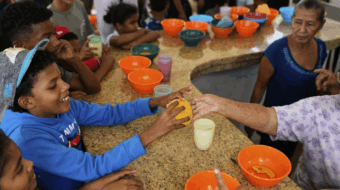
“John Brown was born just as the shudder of Haiti was running through all the Americas,” wrote his biographer W. E. B. Dubois. Indeed, “The prospect of Cuban independence raised the specter of another black republic in the Caribbean,” said historian Louis A. Perez Jr. That worried Winston Churchill, in Cuba reporting on Cuba’s second War for Independence in 1895: “A grave danger represents itself. Two fifths of the insurgents in the field are Negros. [They would] demand the predominant share in the government.”
“Those people are no more fit for self government than gunpowder is for hell,” said U.S. General William R. Shafter from Cuba a few years later. “The insurgents are a lot of degenerates,” offered General Samuel Young of the U.S. occupation forces. Major Alexander Oswald Brodie said, “The Cubans are utterly irresponsible, partly savage.”
Beginning in 1868, Cuba’s African-descended General Antonio Maceo fought to end slavery and win Cuban independence. After 1895, he and his ragtag army were instrumental in ending Spanish colonialism. Like former Haitian slave Toussaint L’Ouverture a century earlier, he led black soldiers to victory over a European power.
A government backed by U.S. military incursions kept the Cuban economy in U.S. hands. Not until 1959 would Cuban revolutionaries gain a second national independence. The use of racism as a tool of oppression would end.
For Monroe Doctrine enforcers in Washington, Haitian independence in 1804 and the victory of the Cuban Revolution represented big fish that got away. They took preventative steps, such as invading the Dominican Republic in 1965 with 42,000 troops and, from the beginning, punishing Haiti.
The U.S. government joined a multinational trade embargo against Haiti in the early 19th century and withheld diplomatic recognition for almost 60 years. In 1825 France forced Haiti to pay billions in gold francs for property losses, i.e. slaves. Payouts, including interest, lasted until 1947, inflicting a chronic open wound upon the Haitian people.
U.S. Marines invaded in 1915 to settle other debts. They stayed until 1934 and ran the government. Haitian former military officer Charlemagne Perault led a guerrilla insurgency requiring U.S. troop reinforcements. Display of his dead body roped to a door represented psychological warfare at its crudest. U.S. Secretary of State Robert Lansing, attempting to justify U.S. occupation, argued that black people have an inherent propensity for the savage life and a physical incapacity for civilization.
Subsequently, U.S. backing of the Duvalier dictatorship, father and son, and use of economic tools to undo food sovereignty reinforced Haitian dependency. Rural people moved into cities, and topsoil disappeared. For President Jean-Bertrand Aristide, the price of popularity and his message of social justice was U.S.-backed coups and exile.
A week after the January 12 earthquake, U.S. media reports cast survivors as potentially violent. Like Afro-Cuban rebels before them, they were scorned. A New York Times columnist attributed Haiti’s misfortunes to a flawed “culture,” given over to Voodoo. “Responsibility is often not internalized,” he suggested. A U.S. radio preacher said that Haitian independence came at the cost of a curse, presumably never to be lifted.
Haitians have long been portrayed as a dependent people, beyond hope. Racist denigration is, of course, commonly used to ward off solidarity for “malcontents.” People seen as lesser human beings require special rules.
In post-earthquake Port-au-Prince, for example, military power became the U.S. response to violent tendencies latent, supposedly, in starving, thirsty, wounded, bereft and grief-stricken people. Doctors, disaster relief specialists and humanitarian aid shipments from dozens of nations were on hold, waiting for guns, tanks, naval ships, and 12,000 U.S. troops to be deployed,
Interviewed on Democracy Now, Dr. Evan Lyon of U.S.-based Partners in Health said, “There are no security issues … and there’s also no violence.” “Racism has slowed the recovery efforts of this hospital,” he concluded.
“Most Haitians here have seen little humanitarian aid so far. What they have seen is guns, and lots of them,” reported Al Jazeera’s Sebastian Walker. Community people were reported to be forming cooperative recovery projects.
For racist oppressors, black people’s yearnings for equality may be dangerous, and so too is organizing for social justice. Marco Rascon, writing for the Mexican La Jornada newspaper, suggests the U. S. government in Haiti is looking at Cuba. “Before the Haitian disaster, powerful Cuban social organizing had begun to extend its networks, medical and educational institutions,” he states. “The force of solidarity goes beyond delivering supplies. It can generate what is feared more: social organization, where the spirit moving the people will be the people.”
Photo: http://www.defense.gov/dodcmsshare/newsphoto/1999-02/981215-M-3661W-001.jpg










